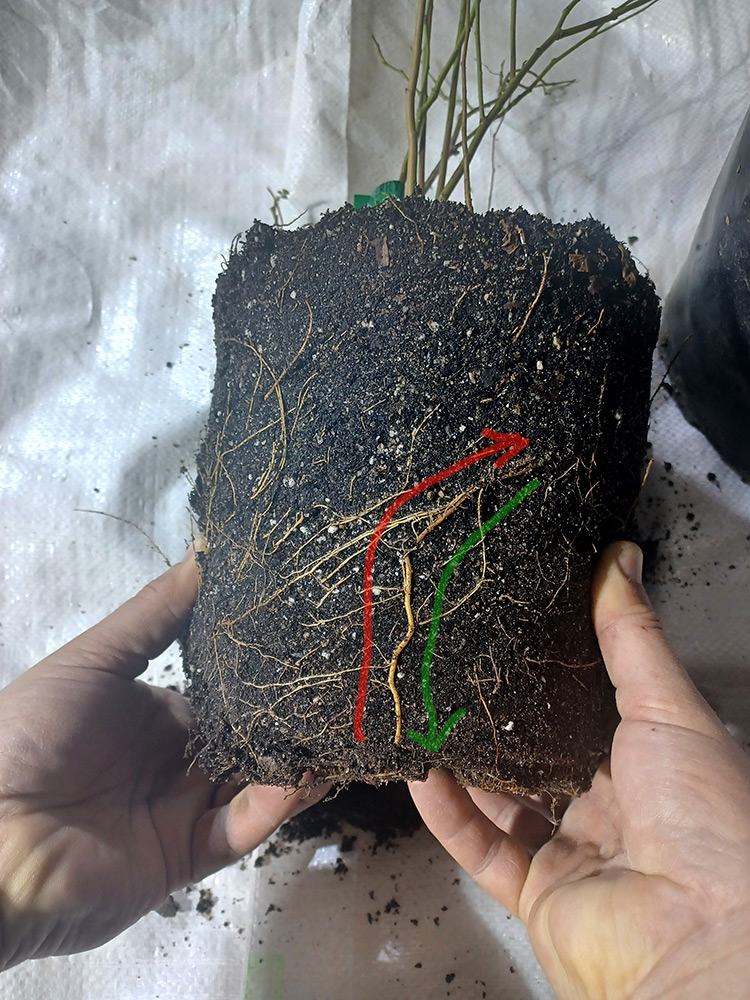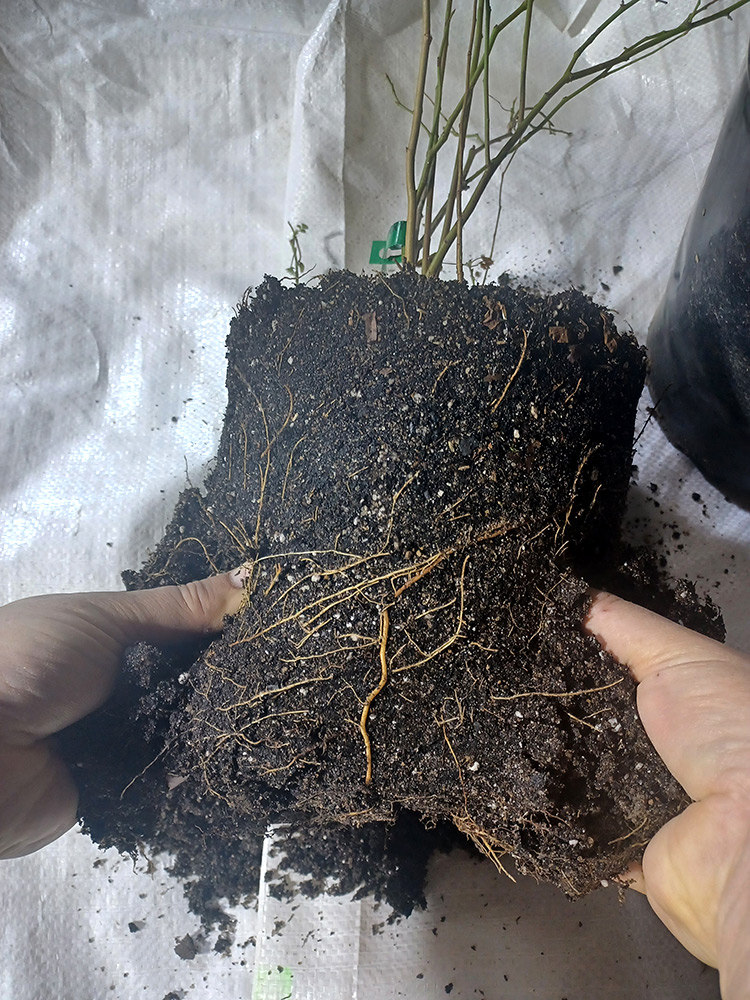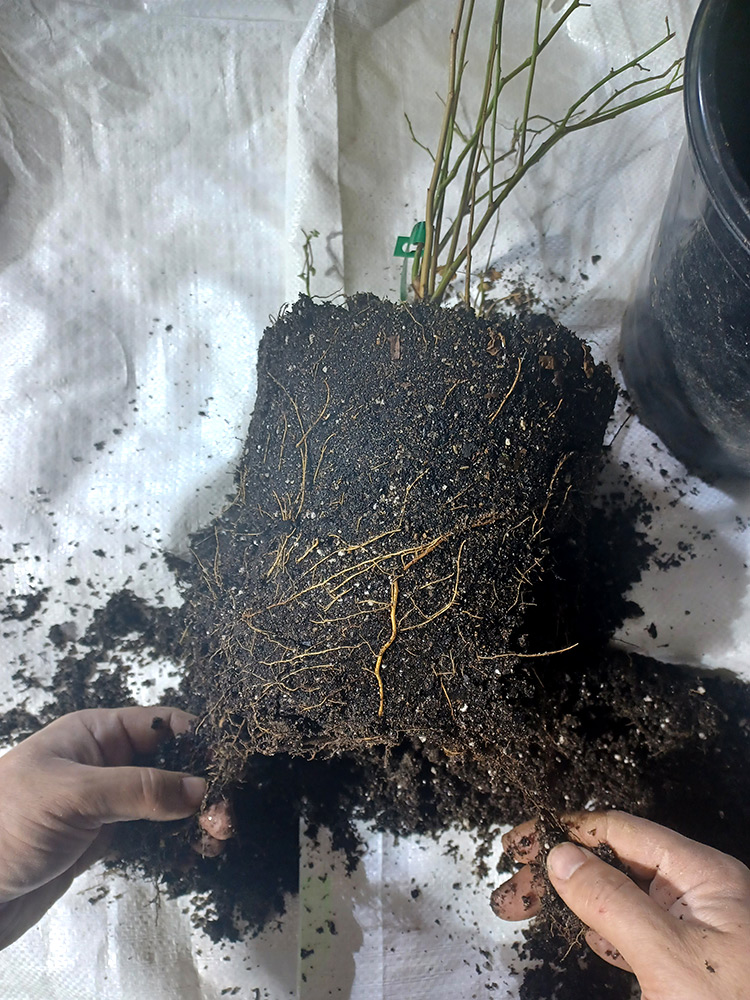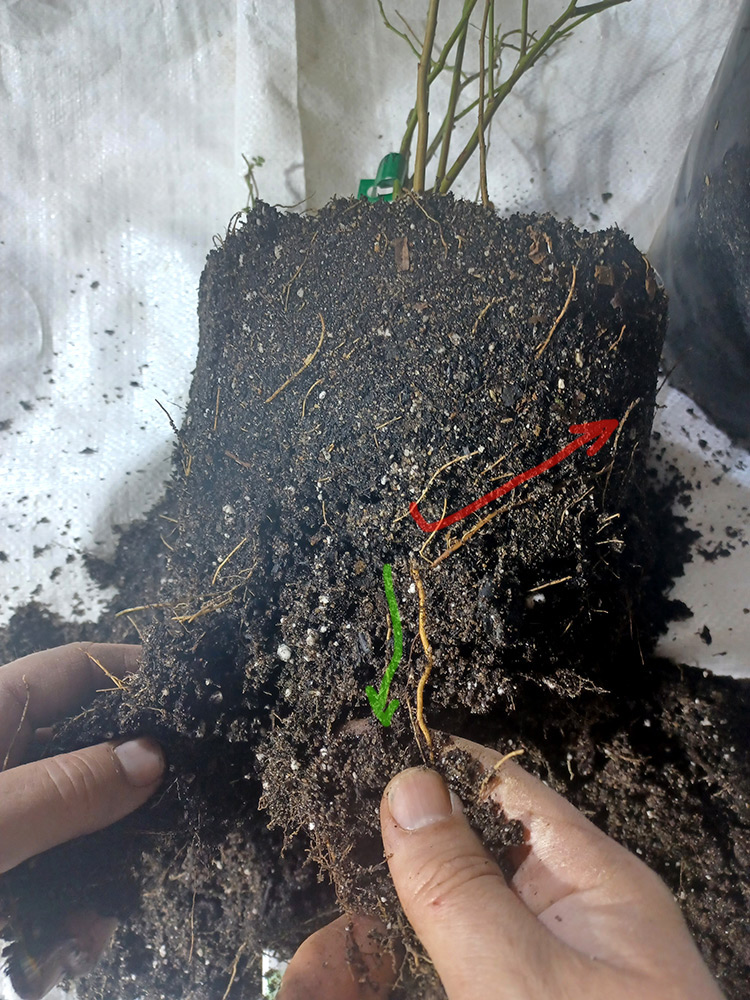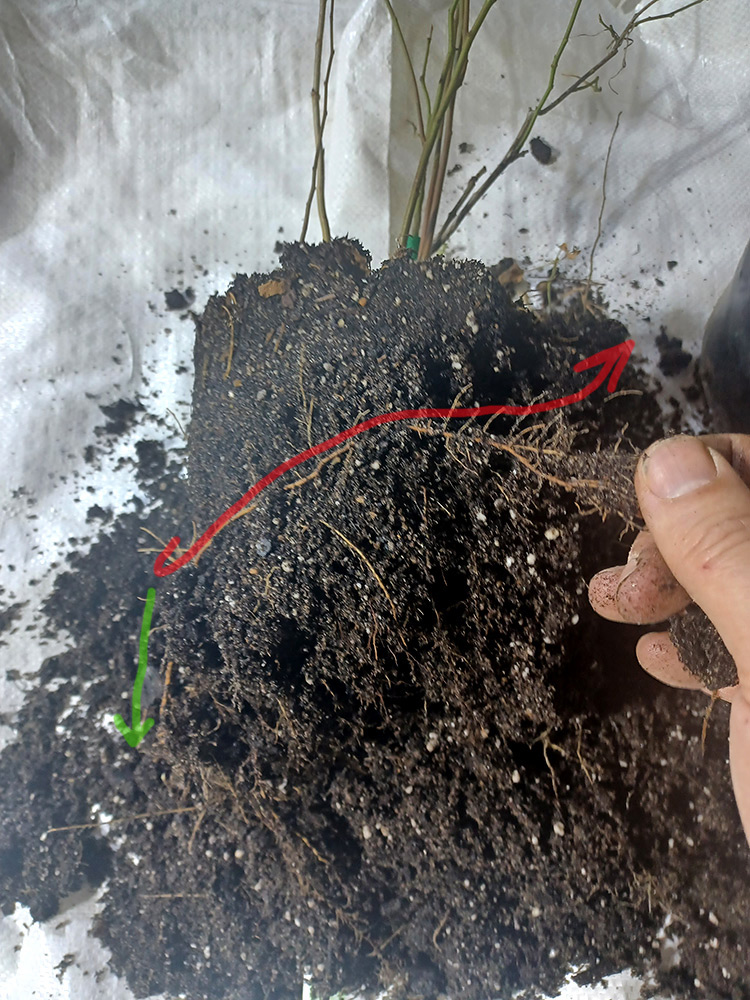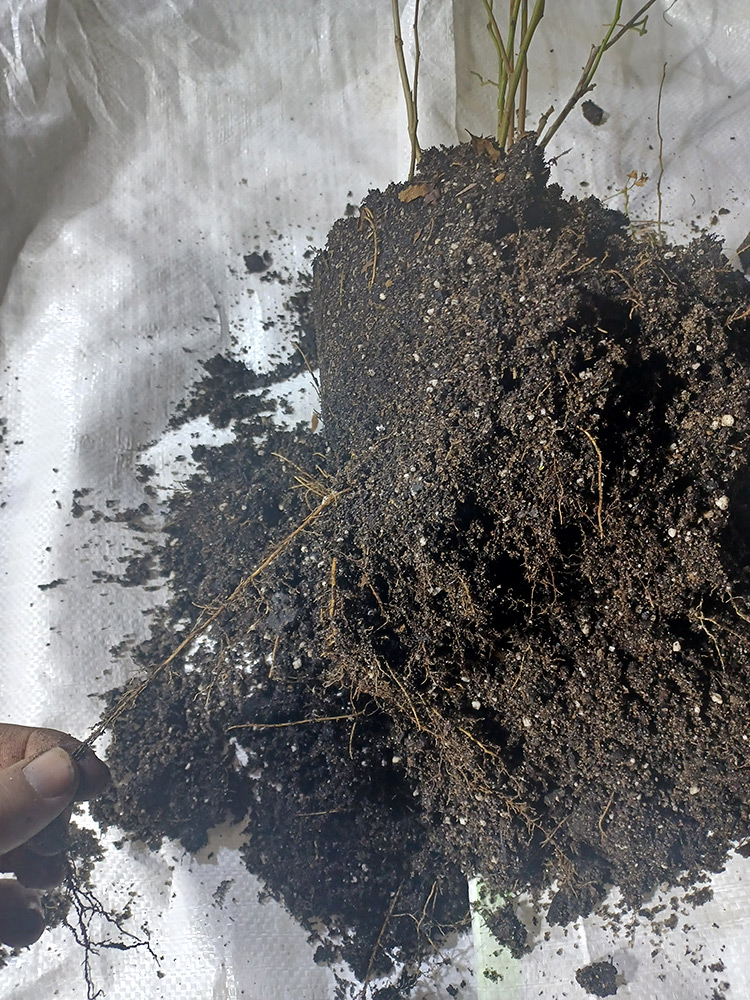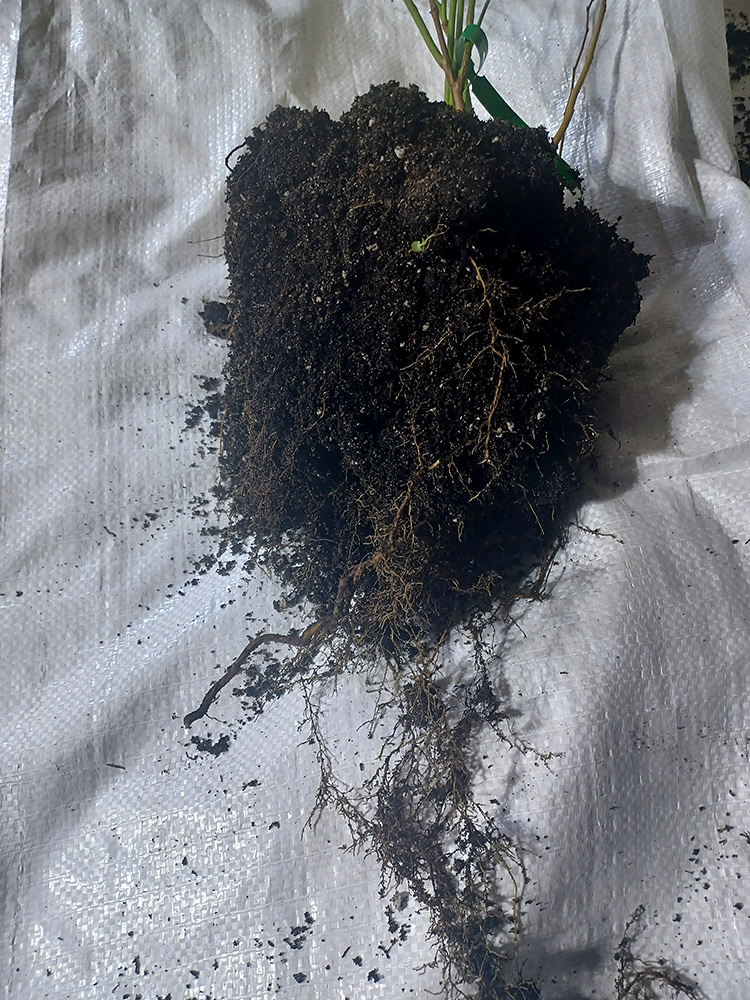With any potted plant, when the roots grow to the pot wall, they don’t just stop growing… Instead, the wall of the pot simply REDIRECTS the growth in a new (random) direction.
The longer a plant grows in a pot, the more roots are redirected.
If a plant sits in a pot too long, the roots can get so redirected and grow so much, they become a complete and total tangled mess. If you don’t deal with a severely rootbound plant before planting in the ground, you’re pretty much sending your plant down the Green Mile.
Dead plant walkin’ here! Dead plant walkin!
While ALL potted plants will be rootbound to some degree, this is one of the biggest problems when buying an older tree from a big box store. In order to keep that tree in proper shape, the roots need at the very least annual attention. Very few box stores moving thousands of trees bother with that time consuming work!
But I digress…
I grabbed a little Blueberry I had in a 2 gallon pot that was sitting off in the “never got around to planting it,” pile.
Let’s take a closer look at what Rootbound is and more importantly, how to deal with it.
Assess The Severity
This plant actually isn’t really rootbound. Rootbound is technically when the roots are all bound up and you’ve actually got a problem plant on your hands.
There are some issues with this blueberry…
If left unaddressed for another season, it would likely become seriously rootbound, but right now it’s just starting to show signs.
And while a tree like this would probably do just fine planted right off, by taking literally, just a couple of minutes, you can make sure your tree has the best start possible.
Pull Apart the Bottom
What you want to do with a rootbound plant is pull apart the bottom of the soil so you can free up the roots.
In most cases, you don’t just want to shake all the soil free. That will shock the plant to the greatest degree.
Instead, you’re trying to break up the lower soil, so you can free or untangle the roots.
Grab the rootball as shown and you’re going to pull outward with your fingers on the bottom. Imagine, you’re a little gopher trying to dig your way up through the bottom.
Try to leave big roots intact. Don’t worry about little roots. The worse the plant is rootbound, the more aggressive you have to manhandle it.
DON’T BE SCARED. A badly rootbound plant will die. A plant with some of its roots ripped away will be fine.
Lastly, I want to point out here this larger main root in the photo. Which way do you think this root is growing? Did it start up top and is growing the green path, down toward the bottom? Or the other way, along the red path?
Good Soil Falls Away
A tree planted in good soil, will fall away without much effort on your part.
In fact, you may have to focus more on NOT ALLOWING the entire rootball to crumble and lose all your soil.
Here, my hands have pulled away, spreading the lower portion of the soil with my fingers.
Free the Roots!
As you pull the soil apart, you’ll almost certainly find some of the larger roots in your fingers.
Hopefully, in a not-so-bad situation, you’ve got the ends of the roots.
Sometimes you’ll find yourself holding the middle of a root that loops back upward, popping out of the soil somewhere completely unexpected.
Take the time to untangle these guys as best you can.
Your goal is to redirect them from any upward direction, to a downward direction.
If a root loops back into the rootball and you can’t find where it’s going and can’t free it, it’s best to break that root at the bottom. This way the part attached to the tree can continue growing down, and the missing part can dry out and go to Tree Root Heaven.
Watch out for Encircling Roots.
As a young tree gets rootbound, most of the roots just bounce around, pushed off into the wrong direction making a tangled mess…
But the roots can also get redirected along the pot wall in a horizontal plane. Imagine a root forming a lasso around the root ball going around and around in the pot.
Encircling roots can inhibit other root growth and eventually choke out and kill a tree if unchecked.
For the most part, higher up in the potted soil, you don’t have to worry too much, because that area is home to mostly little feeder roots. Unless the plant is rootbound really bad.
HOWEVER, always remove a little soil right where the trunk meets the soul and make sure you don’t have any roots, of any size, encircling right there. That can happen with a poorly planted tree and encircling roots right at the trunk always cause a serious problem.
Remember that root I asked about here earlier, well it turns out that root reached the pot wall then SPLIT in two directions, one direction going down where we want it, but the other one… well, let’s just take a closer look by turning the plant…
Danger Will Robinson, Danger!
That upward directed root traveled more than half the distance of the pot!
It was headed up, to the surface of the soil. Root bro, you’re going the wrong way.
Here I am, having it pulled the far end out.
This is a prime example of an encircling root.
Which way it would have continued to grow, who knows…
Calm down tree!
but now we know it’s going to grow in the proper direction.
In this image, you can see I’ve pulled the root out and back down in the same direction of his split-mate.
I lost more soil than I would have liked here. And if this had been a growing apple tree, it certainly wouldn’t have been happy being disturbed to this degree…
in the short term.
But in the long-term, Mr. Apple Tree would thank me for the help and we’d be best buddies again.
Roots Grow Down.
Since this little Blueberry wasn’t in bad shape, I didn’t have many roots to wrestle free.
Most of the soil I lost wasn’t from pulling roots free, but simply from the soil breaking away as I handled it.
If you have to plant a rootbound tree like this (or worse), once you free up the roots, the best way to plant the tree isn’t actually to plop all the roots straight down, into the planting hole. That’ll work, but…
The best technique is to actually spread the roots out in all directions as best you can. Not only does this give the tree the best chance in finding nutrients, but it allows the roots more room to grow reducing competition with each other.
Remember: If you rip away some smaller roots, or ends of some roots, that’s not a problem at all. In fact, in this picture here, I could take a scissor and snip the lower few inches of the roots completely off to allow myself an easier planting. This is called ROOT PRUNING and it can actually help stimulate additional root growth.
I recommend folks plant wide and shallow.
With my potted trees, the center point of the planting hole only needs to be the depth of the soil in the pot. BUT in the instance of a rootbound tree, you might unravel the roots and find you have 18″ inches of roots to plant! Let’s pretend that’s the length of the roots in this last photo.
You don’t want to grab the bottom of the roots and stretch them out beyond the sides of your planting hole, slanting them upward into a shallower area. This is a lazy way to do it.
Instead, widen your planting hole to accommodate the whole length of roots and keep the roots in a downward or horizontal orientation. Of course, if the roots are healthy and numerous enough, you can also opt for the prune, so you do NOT have to adjust the hole size at all.
It’s always good to keep all the strong healthy roots you can, just don’t be fearful of a little root pruning.
I don’t have a picture of a severely rootbound tree right now, maybe I’ll find one on the internet and come back with it…
But if you ever encounter a potted tree that’s massively rootbound (and you can’t take it back), you can perform what’s called a BOX CUT.
You set the tree before you. No need to worry about the soil falling away, because in a horribly rootbound tree, the pot is 90% roots and hardly has any soil anyway.
So you put the tree before you, get yourself a saw, and you make 4 vertical cuts straight down. Like cutting a cake.
But instead of a slice of cake, you’re basically left with a cube of roots.
The idea is that once all the roots are severed and placed in the ground, they are free to grow out and away from the trunk as originally intended.
What happens below the soil is just as important for a fruit tree as what happens above. A minute or two inspecting every tree before it goes into the ground, will be years of saved time later.

